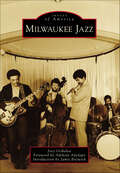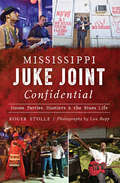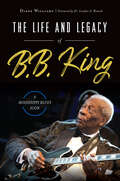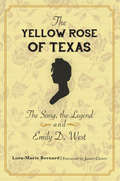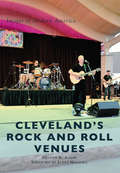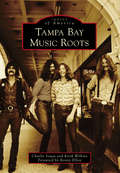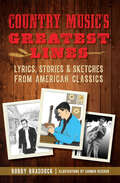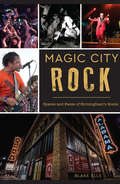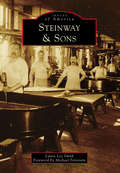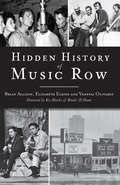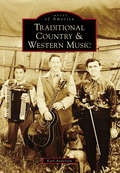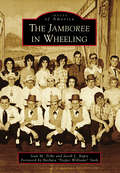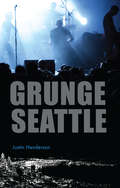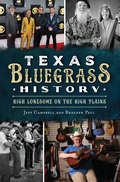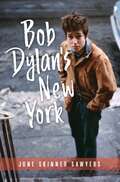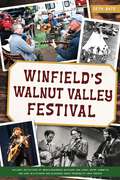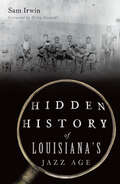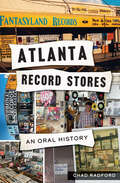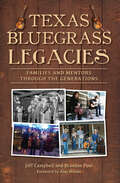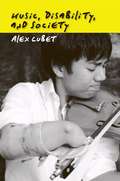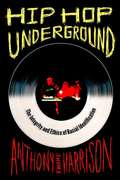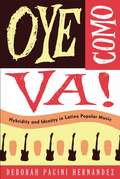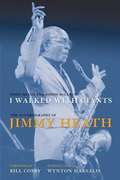- Table View
- List View
The Erie Canal Sings: A Musical History of New York's Grand Waterway
by Bill Hullfish Dave RuchLife working along the banks of the Erie Canal is preserved in the songs of America's rich musical history. Thomas Allen's "Low Bridge, Everybody Down" has achieved iconic status in the American songbook, but its true story has never been told until now. Erie songs such as "The E-ri-e Is a-Risin'" would transform into "The C&O Is a-Risin'" as the song culture spread among a network of other canals, including the Chesapeake and Ohio and the Pennsylvania Main Line. As motors replaced mules and railroads emerged, the canal song tradition continued on Broadway stages and in folk music recordings. Author Bill Hullfish takes readers on a musical journey along New York's historic Erie Canal.
St. Louis Jazz: A History
by Dennis C OwsleyExplore the history of the artists who contributed to the Gateway City&’s jazz scene and the world of music.In the early twentieth century, St. Louis was a hotbed for ragtime and blues, both roots of jazz music. In 1914, Jelly Roll Morton brought his music to the area. In 1919, Louis Armstrong came to town to play on the &“floating conservatories&” that plied the Mississippi. Miles Davis, the most famous of the city&’s jazz natives, changed the course of the genre four different times throughout a world-renowned career. The Black Artists Group of the 1970s was one of the first to bring world music practices into jazz. Author Dennis C. Owsley chronicles the ways both local and national St. Louis musicians have contributed to the city and to the world of music.
Milwaukee Jazz (Images of America)
by Joey GrihalvaMilwaukee's jazz scene has forever stood in the shadow of Chicago's illustrious institution, but it stands strong. Cream City has produced a wealth of talent, attracted top-notch transplants, and hosted legends like Duke Ellington, Dizzy Gillespie, Herbie Hancock, Billie Holiday, and Wynton Marsalis. From the heyday of the 1940s and 1950s to the renaissance of the 1970s, from the streets to the classrooms, from grand ballrooms to outdoor festivals, from swing to bebop, from smoky bars to dimly lit clubs like the Flame, Thelma's Back Door, and the Jazz Gallery, Milwaukee has been a hotbed of improvised music, providing a noteworthy contribution to the story of jazz in America.
Mississippi Juke Joint Confidential: House Parties, Hustlers & the Blues Life
by Roger StolleJuke joint--two words often used, often abused. They convey an inherent promise of something real, edgy, from another time. All juke joints are blues clubs, but not all blues clubs are jukes. Here, artist recollections and insights delve below the murky surface to tell the tales, canonize the characters and explain the special brand of blues bottled in these quasi-legal establishments. Author Roger Stolle works from the inside to educate and entertain with a mix of history, anecdote and discovery. It's a wild ride.
Life and Legacy of B. B. King: A Mississippi Blues Icon (American Heritage)
by Diane WilliamsThis biography of the iconic blues musician features interviews with family members, fellow musicians, and those who knew his best.Born on a cotton plantation in 1925, Riley B. King would grow up to be one of the most influential blues musicians of all time, being crowned &“The King of the Blues.&” Never wavering from his vocation, King gathered other musicians together and melded them into the unique blues sound that would become his signature. In this intimate portrait of B. B. King, author Diane Williams offers a brief account of the monumental blues man's life before settling in for a series of interviews with his bandmates and beloved family members. The Life and Legacy of B. B. King offers an intimate view of the man behind the music.
The Yellow Rose of Texas: The Song, the Legend and Emily D. West
by Lora-Marie BernardA journalist searches for the truth behind the traditional folk song, and a free black woman’s role in the Texas Revolution.The legend of the Yellow Rose of Texas holds an indisputable place in Lone Star culture, tethered to a familiar song that has served as a Civil War marching tune, a pop chart staple, and a halftime anthem. Almost two centuries of Texas mythmaking successfully muddled fact with fable in song, and the true story of Emily D. West remains mired in dispute and unrecognizable beneath the tales that grew up around it. The complete truth may never be recovered, but in this book Lora-Marie Bernard seeks an honest account honoring the grit and determination that brought a free black woman from the abolitionist riots of Connecticut to the thick of a bloody Texas revolution. A Lone Star native who grew up immersed in the Yellow Rose legend, Bernard also traces other stories that legend has obscured, including the connection between Emily D. West and plans for a free black colony in Texas.Includes illustrations
Cleveland's Rock and Roll Venues (Images of Modern America)
by Deanna R. AdamsCleveland has always been a music town. And thanks to Cleveland deejay Alan Freed, who booked the first venue for rock enthusiasts, music fans have never lacked for places to go see their favorite acts perform in person. This book honors the astute owners and their venues--from yesterday to today--that present fans with the music they crave. The early clubs helped usher in Cleveland as the designated Rock and Roll Capital of the World. Today's venues continue the tradition, thus ensuring that music lovers of all ages, and attitudes, get to enjoy their rock and roll on the North Coast, with all its variety and talent. Because of them, musical memories continue to be made.
Tampa Bay Music Roots (Images of America)
by Charlie Souza Keith WilkinsWhen the Peerless Quartet wrote "Way Down On Tampa Bay" in 1914, Tampa Bay's musical roots started growing. Tampa Bay is where Ray Charles created his first song, Hank Ballard wrote and recorded "The Twist," and the Rolling Stones cranked out their hit "Satisfaction." Stephen Stills attended both Plant High School and Admiral Farragut Academy, and Jim Morrison studied at St. Petersburg Junior College. Ella Fitzgerald kicked off her career on the storied Central Avenue in Ybor City. Savatage, Stranger, Diamond Grey, the Outlaws, Bleeding Hearts, Blackkout, the Arena Twins, Tampa Red, and Cheeky Monkey are all artists who have made a huge impact both locally and nationally. From its rock 'n' roll boom in the 1960s to the birth of death metal in the 1980s . . . Tampa Bay has had a rich musical history!
Country Music's Greatest Lines: Lyrics, Stories & Sketches from American Classics
by Bobby Braddock&“One of country music&’s greatest songwriters has given us his own private tour of the collective genius of his profession.&” —Malcolm Gladwell, bestselling author and host of the Revisionist History podcast Bobby Braddock, the only living songwriter to have written number-one country songs in five consecutive decades, celebrates standout lines in more than eighty country masterpieces. Unique stories give the reader a behind-the-scenes look at classics from Hank Williams, Bill Anderson, Roger Miller and Merle Haggard, as well as twenty-first-century icons like Alan Jackson, Taylor Swift and Eric Church. Artist Carmen Beecher brings these tales to vivid life with strikingly realistic illustrations of seldom-seen songwriters, easily recognizable superstars and unforgettable song characters. From late 1940s jukebox hits to present-day chart toppers, Braddock and Beecher offer a magical journey from the songwriter&’s pen to the singer&’s lips to the listener&’s ear. &“Country Music&’s Greatest Lines works as an insider&’s take on the business of country, and it also sent me to a dozen records I wanted to hear immediately. Braddock and Beecher evoke the mythology of country without sentimentalizing the music or its creators. It&’s a remarkable achievement.&” —Nashville Scene &“We see how stand-alone powerful and effective a few well-crafted lines can be, even when removed from the context of the entire song.&” —Sounds Like Nashville &“Country songs, from Hank Williams till today, remain faithful to their tradition of reminding their listeners about the life they live. Braddock, a 60-year creator of songs, remembered that when he decided to write this book.&” —American Songwriter
Magic City Rock: Spaces and Faces of Birmingham’s Scene
by Blake EllsBirmingham's rock music scene has thrived on camaraderie and collaboration for decades. With no competitiveness, it has maintained a punk rock ethos while also appealing to a mainstream audience, thanks to DIY clubs and alternative radio support. Once one of the country's most successful AAA radio stations, 107.7 The X and the A&R power of station head Scott Register provided the early radio success that helped break Train, Matchbox Twenty and John Mayer. The same scene produced Jim Bob & the Leisure Suits, the Primitons, the Sugar La Las and Verbena. From local legends like Hotel and Telluride to national sensation St. Paul and the Broken Bones, writer Blake Ells tells the story of the Magic City's indelible stamp on the history of modern rock.
Steinway & Sons (Images of America)
by Laura Lee SmithThis history of the iconic piano brand chronicles the story of an immigrant family, American ingenuity, and more than a century of musical excellence. The legendary piano maker Steinway & Sons holds a unique place in American history. The name alone conjures many things: a symbol of class and elegance, an American success story, an area of New York City, and the height of craftsmanship. From their factory in Queens, located on Steinway Place, the company has touched the hearts of millions across the world, from piano teachers and students to world-class musicians, and from salespeople to artisans, audiences, and music lovers. After leaving his native Germany for America in 1850, Henry E. Steinway established his new enterprise with a simple but ambitious mission &“to build the best piano possible.&” In the late 19th century, Steinway emerged as the standard-bearer in piano design and manufacturing, outshining and outlasting other brands including Chickering and Weber. Today, the Steinway piano is still built by hand in New York City according to the same stringent processes developed by Henry E. Steinway and his sons more than a century ago.
Hidden History of Music Row (Hidden History)
by Brian Allison Elizabeth Elkins Vanessa OlivarezNashville's Music Row is as complicated as the myths that surround it. And there are plenty, from an adulterous French fur trader to an adventurous antebellum widow, from the early Quonset hut recordings to record labels in glass high-rise towers and from "Your Cheatin' Heart" to "Strawberry Wine." Untangle the legendary history with never-before-seen photos of Willie Nelson, Patsy Cline, Kris Kristofferson and Shel Silverstein and interviews with multi-platinum songwriters and star performers. Authors Brian Allison, Elizabeth Elkins and Vanessa Olivarez dig into the dreamers and the doers, the architects and the madmen, the ghosts and the hit-makers that made these avenues and alleys world-famous.
Traditional Country & Western Music (Images of America)
by Karl AndersonTraditional Country & Western Music presents historical photographs, memorabilia, and stories about an enduring music genre that took root in America from the late 1920s through the mid-1930s. Although many of our early folk songs originated from the British Isles, Jimmie Rodgers (the "Father of Country Music") and Gene Autry ("America's Favorite Singing Cowboy") became the foundation of modern country and western music. Many regional styles and variations of country and western music developed during the first half of the 20th century, including hillbilly, bluegrass, honky-tonk, rockabilly, southern gospel, Cajun, and Texas swing. Local artists, live radio shows, and regional barn dance programs provided entertainment throughout the Great Depression, World War II, and into America's postwar years. During the 1950s, country and western music became homogenized with the Nashville sound and the Bakersfield sound. By the end of the 1960s, country music completed its move to Nashville, and "western" was dropped from the equation. This book recalls the golden age of country and western music from the late 1920s through the 1960s. Each of the featured artists and programs in this book were once household names. We celebrate these early legends, live radio and television shows, unsung heroes, and local performers from Maine to California.
The Jamboree in Wheeling (Images of America)
by Ivan M. Tribe Jacob L. BapstBeginning in the mid-1920s, radio stations that catered to rural audiences sponsored programs featuring country music, generically termed "barn dances." Ranking second in terms of longevity and perhaps in significance to the Grand Ole Opry from WSM Nashville came the Jamboree in Wheeling, West Virginia. It became the springboard for such country stars as Wilma Lee and Stoney Cooper, Hawkshaw Hawkins, the Osborne Brothers, Doc and Chickie Williams, Lee Moore, Big Slim the Lone Cowboy, and most recently, Brad Paisley. Under slightly varying names, the Jamboree flourished from 1933 through 2005 over the airwaves of 50,000-watt WWVA 1170 AM and now airs on WWOV 101.1 FM.
Grunge Seattle
by Justin HendersonChronicling the intertwined lives of members of core grunge bands, Grunge Seattle reveals the origins and inspirations of the grunge movement. Delve into the collisions between personalities and egos, artists and corporations, suburbs and cities, obscurity and fame. Explore the cafés, apartments and studios where Nirvana, Pearl Jam, Soundgarden, Mudhoney and Alice in Chains practiced and played. In this reprint edition, originally published in 2010 and revised in 2016, writer, surfer and longtime Seattlite Justin Henderson provides a unique guide to the key locations in the story of grunge.
Texas Bluegrass History: High Lonesome on the High Plains
by Jeff Campbell Braeden PaulTexas has nurtured a thriving bluegrass scene since the early 1950s. The Lone Star State boasts the country's first bluegrass college degree and even hosts a Beatles bluegrass cover band. Meet the Pickin' Singin' Professor, the Fiddle Engineer and Blanco's Bluegrass Boy. Hit the trail with cowboys like the Mayfield brothers and go backstage with Grammy-nominated acts like Wood & Wire. Jeff Campbell and Braeden Paul celebrate the musicians who contributed to the harmonious heritage of Texas bluegrass.
Bob Dylan's New York
by June Skinner SawyersOn a snowy winter morning in 1961, Robert Zimmerman left Minnesota for New York City with a suitcase, guitar, harmonica and a few bucks in his pocket. Wasting no time upon arrival, he performed at the Cafe Wha? in his first day in the city, under the name Bob Dylan. Over the next decade the cultural milieu of Greenwich Village would foster the emergence of one of the greatest songwriters of all time. From the coffeehouses of MacDougal Street to Andy Warhol's Factory, Dylan honed his craft by drifting in and out of New York's thriving arts scenes of the 1960s and early ,70s. In this revised edition, originally published in 2011, author June Skinner Sawyers captures the thrill of how a city shaped an American icon and the people and places that were the touchstones of a legendary journey.
Winfield's Walnut Valley Festival
by Seth Bate Dan Crary Beppe Gambetta John McCutcheon Orin FriesenLocal historian Seth Bate tells the story of the Walnut Valley Festival with reflections from staff, emcees, performers, campers, and characters from throughout its history.The Festival was launched in 1972 when a guitar maker, a farmer, and a businessman built their own music festival from the ground up. It has made the small town of Winfield into an annual destination for acoustic musicians and music lovers from around the world and it has always been participatory, with the informal campsite pickin' as much a part of the event as the stage shows and instrumental contests. The Walnut Valley Festival has always been proud of its deep-rooted traditions, but most of all, it is a community celebration.
Hidden History of Louisiana's Jazz Age
by Sam IrwinStep backstage in this look at little-known and utterly fascinating aspects of Jazz Age Louisiana.New Orleans' early jazz greats like Louis Armstrong, Jelly Roll Morton, Kid Ory and Buddy Bolden had fascinating careers, but Hidden History of Louisiana's Jazz Age is filled with tales of murder, lust and adventure. Clarinetist Joe Darensbourg of Baton Rouge ran away and joined the circus three times before the age of 20. The Martel Band of Opelousas witnessed a legal public hanging of a convicted serial murderer in 1923 Evangeline Parish. Trumpeter Evan Thomas of Crowley could have been a rival to Satchmo but was cut down on the bandstand in the Promised Land neighborhood of Rayne, La. Author Sam Irwin explores the odd and quirky in these fascinating stories of the Roaring Twenties.
Atlanta Record Stores: An Oral History
by Chad RadfordAtlanta Record Stores is an oral history of the city's rock music scene, as witnessed through the lens of Criminal Records, Fantasyland, Wax 'N' Facts, and many more. This is a rock-centric take on a town that's so often praised and admired around the world as a hip-hop mecca. Here, the secret history of the underdogs--outsiders living among outsiders--are told. From Jarboe of SWANS to William DuVall of Alice In Chains and Neon Christ, to Kelly Hogan, and those surly guys behind the counter at Wuxtry, all were drawn by the irresistible lure of vinyl records, all found their communities and their own identities, leaving an indelible mark on the culture of Atlanta. Now, in their own voices, their stories are told.
Texas Bluegrass Legacies: Families and Mentors through the Generations
by Jeff Campbell Braeden PaulEnjoy a breakdown of the Lone Star State's generational bluegrass harmonies. From the moment they picked up the radio signal of Bill Monroe's mandolin, Texans have been enamored with this uniquely American style of music. But the high lonesome sound couldn't have put down roots without a tradition of mentorship that runs through families and spans generations. Meet the Van Cliburn piano prodigy that became a multi-instrumentalist for Taylor Swift. Travel to the summer bluegrass camp where students develop into teachers. Sit in on a back porch jam session with the Rogers, the Brocks, the Vestals and the Whites. From the state's first Asian-American bluegrass family to its banjo-building Santa Claus, Jeff Campbell and Braeden Paul set the stage for the stewards of Texas bluegrass.
Music, Disability, and Society
by Alex LubetMusical talent in Western culture is regarded as an extraordinary combination of technical proficiency and interpretative sensitivity. In Music, Disability, and Society, Alex Lubet challenges the rigid view of technical skill and writes about music in relation to disability studies. He addresses the ways in which people with disabilities are denied the opportunity to participate in music. Elaborating on the theory of "social confluence," Lubet provides a variety of encounters between disability and music to observe radical transformations of identity. Considering hand-injured and one-handed pianists; the impairments of jazz luminaries Django Reinhardt, Horace Parlan, and "Little" Jimmy Scott; and the "Blind Orchestra" of Cairo, he shows how the cultural world of classical music contrasts sharply with that of jazz and how musicality itself is regarded a disability in some religious contexts. Music, Disability, and Society also explains how language difference can become a disability for Asian students in American schools of music, limiting their education and careers. Lubet offers pungent criticism of the biases in music education and the music profession, going so far as to say that culture disables some performers by adhering to rigid notions of what a musician must look like, how music must be played, who may play it, and what (if any) is the legitimate place of music in society. In Music, Disability, and Society, he convincingly argues that where music is concerned, disability is a matter of culture, not physical impairment.
Hip Hop Underground: The Integrity and Ethics of Racial Identification
by Harrison Anthony KwameRace and authenticity in America, explored through the Bay Area's multiracial underground hip hop scene
Oye Como Va!: Hybridity and Identity in Latino Popular Music
by Hernandez Deborah PaciniListen Up! When the New York-born Tito Puente composed "Oye Como Va!" in the 1960s, his popular song was called "Latin" even though it was a fusion of Afro-Cuban and New York Latino musical influences. A decade later, Carlos Santana, a Mexican immigrant, blended Puente’s tune with rock and roll, which brought it to the attention of national audiences. Like Puente and Santana, Latino/a musicians have always blended musics from their homelands with other sounds in our multicultural society, challenging ideas of what "Latin" music is or ought to be. Waves of immigrants further complicate the picture as they continue to bring their distinctive musical styles to the U. S. -from merengue and bachata to cumbia and reggaeton. In Oye Como Va!, Deborah Pacini Hernandez traces the trajectories of various U. S. Latino musical forms in a globalizing world, examining how the blending of Latin music reflects Latino/a American lives connecting across nations. Exploring the simultaneously powerful, vexing, and stimulating relationship between hybridity, music, and identity, Oye Como Va! asserts that this potent combination is a signature of the U. S. Latino/a experience.
I Walked with Giants: The Autobiography of Jimmy Heath
by Heath Joseph Jimmy MclarenComposer of more than 100 jazz pieces, three-time Grammy nominee, and performer on more than 125 albums, Jimmy Heath has earned a place of honor in the history of jazz. Over his long career, Heath knew many jazz giants such as Charlie Parker and played with other innovators including John Coltrane, Miles Davis, and especially Dizzy Gillespie. Heath also won their respect and friendship. In this extraordinary autobiography, the legendary Heath creates a “dialogue” with musicians and family members. As in jazz, where improvisation by one performer prompts another to riff on the same theme, I Walked with Giants juxtaposes Heath’s account of his life and career with recollections from jazz giants about life on the road and making music on the world’s stages. His memories of playing with his equally legendary brothers Percy and Albert (aka “Tootie”) dovetail with their recollections. Heath reminisces about a South Philadelphia home filled with music and a close-knit family that hosted musicians performing in the city’s then thriving jazz scene. Milt Jackson recalls, “I went to their house for dinner…Jimmy’s father put Charlie Parker records on and told everybody that we had to be quiet till dinner because he had Bird on…. When I [went] to Philly, I’d always go to their house. ” Today Heath performs, composes, and works as a music educator and arranger. By turns funny, poignant, and extremely candid, Heath’s story captures the rhythms of a life in jazz.


